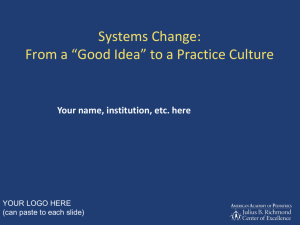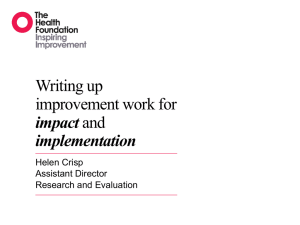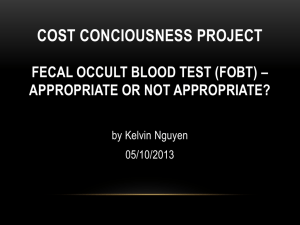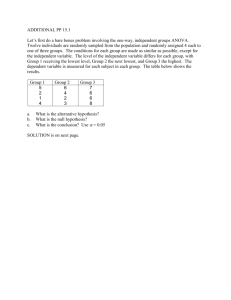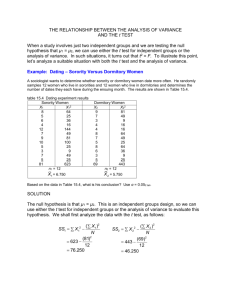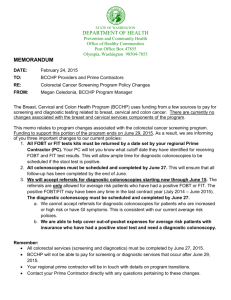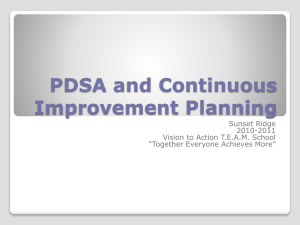Quality Improvement Training for Vermont Quality Leaders
advertisement
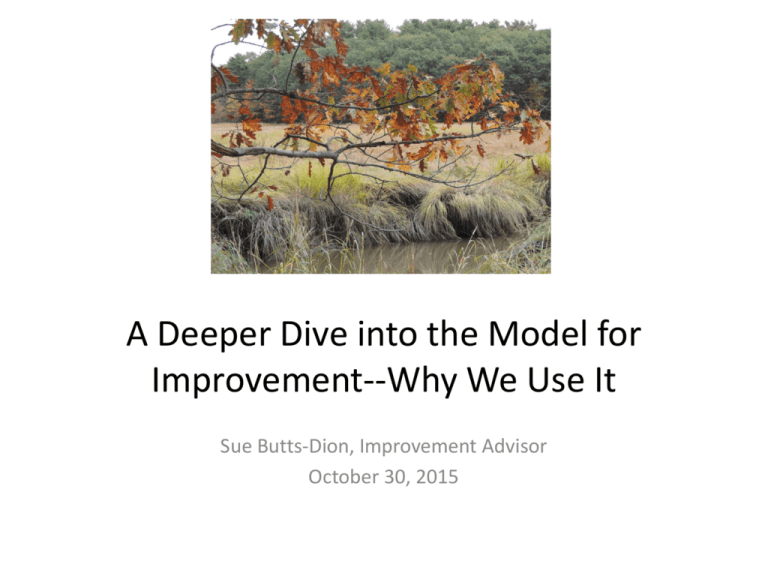
A Deeper Dive into the Model for Improvement--Why We Use It Sue Butts-Dion, Improvement Advisor October 30, 2015 Aim • Participants leave session with: – Ideas for ways to identify improvement opportunities that will improve quality & safety – Better understanding of the elements of the Model for Improvement and how to use the PlanDo-Study-Act cycles to “learn their way to implementation” – Clarification of “testing” – New ideas to apply to existing and/or new improvement projects Before we begin with Model for Improvement… • We know a lot about what can be done to improve quality & safety and to reduce harm… • No loss for things to do. • Improved referral and follow processes • Improved care transitions and handoffs • Medication management • Improved systems for communications • Efficient use of EHRs • Etc, etc. Alignment around definition of quality Quality Definition • The Quality Chasm report described broad quality issues and defined six aims. Care should be: – – – – – – Safe Effective Patient-centered Timely Efficient Equitable How does your team define quality? • If you haven’t defined quality, how might you plan to have this important discussion? • If you have defined quality, how are you communicating that widely so that all are aligned? http://iom.nationalacademies.org/Global/News%20 Announcements/Crossing-the-Quality-Chasm-TheIOM-Health-Care-QualityInitiative.aspx#sthash.f59Mn89A.dpuf Baseline Assessment – The things that “keep you up at night” are great places to start your work. – Then dig a little deeper to see if there are things that should be “keeping you awake” at night Baseline Assessments Some Favorites – Clinical data – Patient survey results – Patient Centered Medical Home (NCQA) criteria – Office systems surveys (e.g., AHRQ Medical Office System of Patient Safety Culture), Assessment of Chronic Illness Care, Clinical Microsystems 5 Ps for Outpatient Primary and Specialty Care) References • http://www.ncqa.org/Programs/R ecognition/Practices/PatientCent eredMedicalHomePCMH.aspx • http://www.ahrq.gov/professiona ls/quality-patientsafety/patientsafetyculture/medi caloffice/userguide/medoffitems.ht ml • http://www.improvingchroniccar e.org/index.php?p=ACIC_Survey& s=35 • https://clinicalmicrosystem.org/w orkbooks/ Considerations • Have you defined quality in your practice? • When and how did you last assess current environment as it relates to quality and safety? • From this assessment, what did you learn that would influence your quality improvement efforts? • If you have not done a recent assessment, how might you attempt that task? “Why” use the Model for Improvement? Why use the Model for Improvement? (Copyright: Associates in Process Improvement) Source: http://www.rch.org.au/uploadedImages/Main/Content/quality/Washington%20Monument.jpg Why? • Because it has been proven effective in helping accelerate change and improvement in healthcare. • Because change and transformation does not happen because of hard work, education and vigilance alone. • Provides a structured way for us to “learn our through improvement and to implementation” via interventions that are designed and tested iteratively. • Keeps us focused on “bad systems” and NOT bad “people”. • Encourages frequent and ongoing measurement to guide our work. Debrief: What did we learn? Goals & Measures? Teams and motivation? PDSA Cycles—Small Tests of Change How have we learned that we can accelerate change and increase improvements in healthcare? The Model for Improvement is a framework intended to guide improvement by helping teams & individuals: •Know what it is they need to improve. •Have a feedback mechanism in place to tell how they are doing. •Develop changes to test. And test them on a small scale before implementing. Question 1: What Are We Trying to Accomplish? Aim statement: – What? – For whom? – By when? – How much? Why? • Traits of High Performing Teams – Clear roles and responsibilities – A clear, valued and shared vision – Optimize resources – Strong team leadership – Provide regular feedback – Develop a strong sense of collective trust, team identity and confidence – Create mechanisms to cooperate, coordinate and generate ongoing collaboration – Manage and TeamSTEPPS optimize performance outcomes What are We Trying To Accomplish? The AIM is • Not just a vague desire to do better • A commitment to achieve measured improvement – In a specific system – With a definite timeline – And numeric goals 18 Smart AIMS • SMART aims – – – – – Specific Measureable Achievable Realistic Time bound Examples… From… • Improve our FOBT return rates. To… • Between October 2015 and July 4th, 2016, improve our FOBT return rates to 60% (currently at median of 15% return rate). We will accomplish this by focusing on: – Refining calendar for reminder letter and phone list generation to improve efficiency and return rates – Develop and implement promotion strategy to increase uptake of FOBT screen – Focused education strategy with patients and with staff Examples… From… • Reduce % readmissions w/in 30 days (Primary care practice). To… • Between October 2015 and July 4th, 2016, participate in a quality improvement (QI) collaborative to decrease potentially avoidable 30-day hospital all cause readmissions by 5% (This equates to approximately 2 fewer patients from our practice each month being readmitted.) Examples… From… • Reduce the time that it takes for us to follow up with patients on abnormal test results. To… • By January 1st, 2016, it will be documented that 90% of our patients with abnormal test results were contacted about their results w/in 24 hours of receipt from the lab and a plan in place for follow up to those results. Your Project Aim? (See worksheet.) • SMART aims – – – – – Specific Measureable Achievable Realistic Time bound • Outcome measures • Process measures • Structural measures (if useful) • Balancing measures (if useful) Examples of Measures for Improvement Projects Increasing FOBT Return Rates • Outcome – Overall FOBT return rate • Process – Percent of patients with reminder calls returning FOBT. – Percent charts with documentation that patient received and understood instructions for FOBT. • Structure – Availability of convenient way to get FOBT returned to the practice. – FOBT covered by insurance. • Balancing – Length of office visits. – Patient satisfaction. Examples of Measures for Improvement Projects Primary Care Practice Collaborative to Reduce Readmissions • Outcome • – Availability of alternative services to provide care (home health, extended practice hours, community care teams, etc.). – Availability of transportation services for patients to get to f/u appointments. – % of patients with phones—reliable ways to be reached. – Practice teams participating in all interventions of the collaborative (phone calls, meetings, etc.) – Collaborative faculty assessment. – % of patients with same cause readmissions to the hospital w/in 30 days • Process – % of patients d/c from hospital with call w/in 48 hours of d/c. – % of patients seen in office w/in 7 days of d/c. – % of patients with medication reconciliation done during office visit. – % of patients informed of how to access emergency care services (other than hospital admission) if need be. Structure • Balancing – Cost to staff extended and weekend hours. – Staff capacity/burn out. – Length of office visits. Examples of Measures for Improvement Projects Reduce time for f/u to abnormal test results • Outcome – % of patients with abnormal test results where documented contact w/in 24 hours of receipt of test result – % of patients with documented f/u plan • Process – Turnaround time from time the lab sends test results until time seen by a provider who can take action – Average number of calls that need to be made to contact patient • Structure – Call scheduling system in place. – Access. – Appropriate notification time parameters defined. • Balancing – Patient satisfaction. Measures for Improvement – Measures are used to bring new knowledge into daily practice – Measures tell a story; goals give a reference point – In improvement we need “just enough” data to learn and inform the next change/test/PDSA – Plot data over time--tracking a few key measures over time is the single most powerful tool a team can use Qualitative & Quantitative • Sources • Patient experience/satisfaction surveys • Employee satisfaction surveys • Solicited and unsolicited data - complaints, letters, cards, stories • Interviews, focus groups • Observation + Measures for Your Project? Many Places to Find Changes to Test • • • • • • Research Evidence/Literature Experience Hunches/Ideas/Theories From Others Results of Assessment Using Improvement Tools (e.g., Flowcharts/flow maps) • Generic Change Concepts (The Improvement Guide 2nd Edition, pgs 357-408) Flow charts—One Great Tool for Displaying and Analyzing Processes-Breaking Down the Complexity High Level (top-down or block diagram) Detail Level (flow chart – several types including value added flow charting) High-Level Diagram • Simplest form of process description. Will help establish boundaries for the process, identify internal customer, and foster conversation. – Identify the major process segments (usually done horizontally so information can be hung below the major process steps) – Write them in the order they occur • If there are more than 8 segments the process might be too large—narrow down Block Diagram—Test Results (Exercise) Patient checks in Patient seen by provider Lab test(s) ordered Test(s) done and results shared Step 2: Hang specific steps related to the bigger “buckets” of work underneath appropriate step, vertically F/u on abnormal results Results shared as needed For another session: Detailed Flowchart Referral Call forwarded to clinic Times Available? Y N Inform Referring Physician Physician Still wish For appt? N Y Call forwarded to clinic Appointment Made Referral cancelled Value Added Analysis • Used to look at each step in a process to determine what, if any, value each step has. – Define process being analyzed – Classify each step • Customer value • Business value • Non-value added – Plan to eliminate non value added – Plan to eliminate or minimize the cost and effort of business value steps Flowcharts and Process Thinking – Key Points • Flowcharts are used to create a picture of a process, to create common understanding of how a process works, and to identify redundant, unclear, misplaced, and unnecessary steps around which you can test. • Flowcharts can be used to standardize processes, creating a best current method, but should first be used to explore the current process. All generate improvement ideas/ concepts and we test changes… • Using Plan-Do-Study-Act cycles. • Relatively small, multiple tests of change. • What can we test with one patient, one visit, one test, one provider, for the next day, etc. API, Model for Improvement Small Test of Change PDSA Cycle A structured trial for a change. Source: W. Edwards Deming The PDSA Cycle Act Objective, Plan questions & Adapt? Adopt ? Abandon? Next cycle? Study Complete the analysis of the data Compare data to predictions Summarize what was learned predictions (why) Plan to carry out the cycle (who, what, where, when) Next Cycle? Do Carry out the plan (on a small scale) Document problems and unexpected observations Begin analysis Plan Do Study Act—Plan! • Plan – Hypothesis or theory – Prediction – Details for small scale: who, what, where, how, when, scope – Data for learning: what, how Plan • What specific question do you want this small test to address? – Example: If we make phone calls w/in 5-7 days after a patient given an FOBT seen in the office, will it result in improved return rates? • Test with the next 5 patients. Plan Do Study Act—Do! Do • Do – Jot down what happened – Record anything different from plan? Plan Do Study Act—Study! • Study – What does it mean? – How did it compare to prediction? – What are we learning? Study Plan Do Study Act—Act! • Act – What shall we do next? • Adopt • Adapt • Abandon Act Benefits to Small-Scale Testing • Learn how to adapt the change to conditions in the local environment • Increase belief that change will result in improvement • Opportunity for “failures” without impacting performance • Identify how much improvement can be expected from the change • Evaluate costs and side-effects of the change • Minimize resistance upon implementation Decrease the Time Frame for a PDSA Test Cycle • Years • Quarters • Months • Weeks • Days • Hours • Minutes Drop down next “two levels” to plan Test Cycle! Test on a Small Scale-Rule of 1! • Conduct the test for one patient, one provider, • • one time, one hour Test the change on a small group of volunteers Simulate the change in some way (when feasible) MODEL FOR IMPROVEMENT A P S D CYCLE:____DATE:____ Objective for this PDSA Cycle PLAN: QUESTIONS: PREDICTIONS: PLAN FOR CHANGE OR TEST: WHO, WHAT, WHEN, WHERE Write it down PLAN FOR COLLECTION OF DATA: WHO, WHAT, WHEN, WHERE DO: CARRY OUT THE CHANGE OR TEST; COLLECT DATA AND BEGIN ANALYSIS. STUDY: COMPLETE ANALYSIS OF DATA; SUMMARIZE WHAT WAS LEARNED. ACT: ARE WE READY TO MAKE A CHANGE? PLAN FOR THE NEXT CYCLE. Hamilton Consulting, LLC & Performance Management Group Work to more robust testing A P S D A P S D 4. Implementation testing 3. Later tests are designed to predict and prevent failures A P S D 2. Then test over a variety of conditions to understand scalability and identify weaknesses 1. Early tests are simple and designed to learn, then succeed Remember the Goal is to “Test”!! Test (www.thefreedictionary.com) test 1 (tst)n. 1. A procedure for critical evaluation; a means of determining the presence, quality, or truth of something; a trial: a test of one's eyesight; subjecting a hypothesis to a test; a test of an athlete's endurance. • 2. A series of questions, problems, or physical responses designed to determine knowledge, intelligence, or ability. • 3. A basis for evaluation or judgment: "A test of democratic government is how Congress and the president work together" (Haynes Johnson). Task (www.thefreedictionary.com) task (tsk)n. • 1. A piece of work assigned or done as part of one's duties. • 2. A difficult or tedious undertaking. • 3. A function to be performed; an objective. Personal Example: Aim to run 7.5 minute mile by July 4th 2016 “4 on the Fourth” road race. (Currently at 10 minute mile) • Task – Develop a training calendar – Buy stop watch – Mark a 4-mile course to practice on – Read a running book • Test – Will borrowing my friend’s light weight running shoes make a difference in my overall time? Test on next 2 runs and measure time. Pop Quiz Test or Task?? • Keep running reports of all patients with high alert drugs/labs • For the next 5 patients on high alert drugs, assess their retention of instructions using teach back method to see if they retained instructions • Hold a meeting • Test warm hand-off procedure with one patient • Collect data • Write policies • Train and educate staff “THERE IS NO KNOWLEDGE WITHOUT THEORY. EXPERIENCE ALONE TEACHES NOTHING.” W. Edward Deming Patient Centeredness • How do you, or might you, engage the patient in testing and improving? Your Turn • Using the PDSA worksheet, develop something that you can test by “next Tuesday”. • Keep the tips for testing in mind. • Test small, test often. Holding the gains during testing… • Test the changes under a wide range of conditions • Work on redesigning processes as opposed to a quick fix only to have it crop up again • Provide information on why the change is being made and how it will affect people--ask for input • Engage patients in the work • Celebrate successes along the way Staff Readiness to Make Change #5: Appropriate Scope for next PDSA Cycle Resistant Indifferent Ready CurrentTip Situation (concept developed by Lloyd Provost) Low Confidence that current change idea will lead to Improvement High Confidence that current change idea will lead to Improvement Cost of Very Small Scale Very Small failure large Test Scale Test Very Small Scale Test Cost of failure small Small Scale Test Very Small Scale Very Small Test Scale Test Cost of Very Small Scale Small Scale failure large Test Test Cost of failure small Small Scale Test Large Scale Test Source: IHI and Lloyd Provost, Associates in Process Improvement Large Scale Test Implement Twenty Questions for Process Analysis Process Step 1 2 3 4 Current Method Reason Better Way Method Chosen Overall Improvement PURPOSE (What?) What happens? Why do it? What else could we do? What should we do? What is the overall improvement? PLACE (Where?) Where is it done? Why do it there? Where else could we do it? Where should it be done? TIME (When?) When is it done? Why do it then? When else could we do it? When should it be done? PERSON (Who?) Who does it? Why them? Who else could do it? Who should do it? PROCEDUR E (How?) How is it done? Why do it this way? What other way could we do it? How should it be done?

